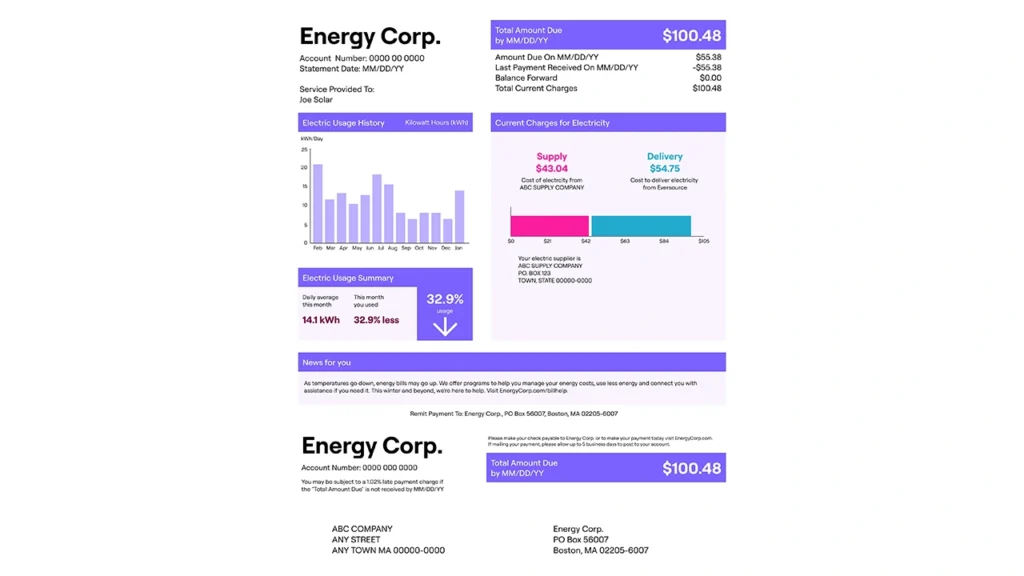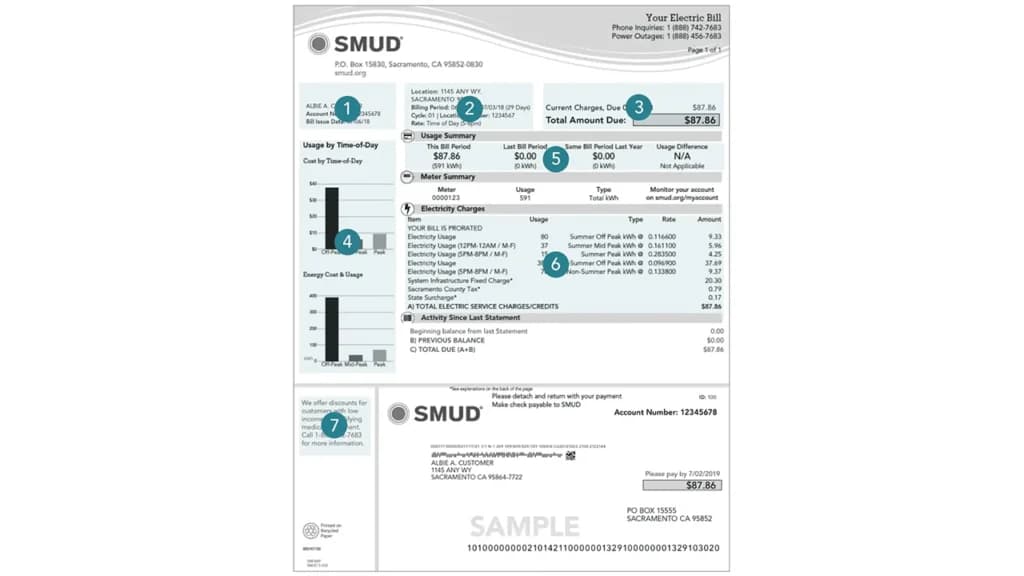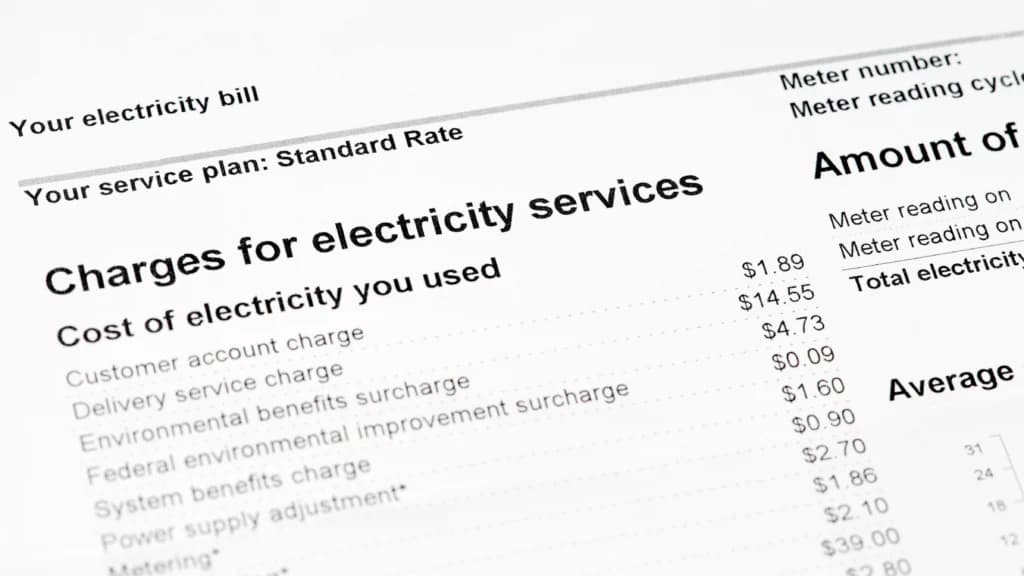Understanding the relationship between your energy generation and bill reduction
One of the primary reasons homeowners adopt solar panels is to reduce their electricity bills. In fact, according to Aurora Solar’s 2025 Solar Snapshot, that’s the case for 72% of homeowners. The more energy your panels generate, the less you have to rely on the power company for electricity. However, it’s not always clear how solar panels work with your electric bill.
In this guide, we’ll explore how it works, how it saves you money, and how net metering can benefit homeowners.
In this article:
- Understanding your electric bill before and after solar
- Net metering: a brief overview
- How solar panels affect your electric bill
- How solar credits appear on your bill
- How to calculate and track your solar savings
- Making the most of energy savings
- Frequently asked questions
Understanding your electric bill before and after solar
Electric bills are complicated. Between all of the miscellaneous charges and energy rates, it can be difficult to decipher them. And once you introduce solar into the mix, they can get even more complicated. But, it doesn’t have to be a source of anxiety, or make you think twice about solar. By learning a few things about your bill and the charges, you’ll get a better grasp about how the electricity billing process works and how solar fits in.
TL;DR? Solar will likely save you money, and you’ll be able to see it on your monthly bill.
To get started, let’s break down the different parts to help you read your electric bill.

Pre-solar electric bill
There are a few line items you’ll see on most energy bills before you go solar:
- Account summary: This section appears at the front of the bill and includes a summary of your charges for the current billing period and any other charges, such as credits, late fees, and adjustments.
- Usage insights: This section will explain your usage patterns and how they change month-over-month.
- Current charges: This breakdown of the bill shows charges in two groups:
- Supply charges: This represents the electricity you used during that period, measured in kilowatt-hours (kWh). If you ever wonder why your electric bill is so high, the surprising amount you used is usually the culprit.
- Delivery charges: These are the fees associated with the utility company physically delivering electricity to your location. If you look at your bill, you’ll probably be surprised to see that these charges are very similar to your supply charges. It’s like ordering a $20 pizza, and getting charged $20 for delivery on top of it. Part of these delivery charges are referred to as minimum monthly connection fees — you would still pay them even if you used no electricity at all in a month.
- Charge details: This section provides a breakdown of utility charges, transmission charges, distribution charges, and taxes and fees.
- Line items: These are all the miscellaneous charges that vary from location to location for utility services. They account for initiatives such as renewable energy programs or low-income assistance programs.
Post-solar electric bill
After going solar, you’ll probably have a few new additions to your electric bill. What these look like depends on your utility company.
- Net metering credits: This will display the energy credits generated that you didn’t use during that period. If you generated more energy than you used, this is often rolled into a credit for future use. Some utilities credit annually — and you receive a true-up statement showing how much energy you sent to the grid — while others do it monthly.
- Time-of-use (TOU): You may have a time-of-use (TOU) section on your bill. This shows how much electricity you used during peak and off-peak times — depending on the time of day, you may pay higher or lower rates. With TOU rates, electricity is more expensive during peak times, when the grid is at its busiest, than during off-peak periods.
Post-solar electric bill breakdown:
1. Account information
2. Homeowner, billing period, and rate plan
3. Current charges
4. Energy cost and usage by time of day (for TOU plans)
5. Usage summary and comparison to previous periods
6. Detailed charge breakdown
7. Utility contact information

Fixed vs variable charges
Specific charges, such as your energy consumption, vary month by month. They’ll change depending on how much energy you use. But other charges, such as fees associated with maintaining the grid, are fixed at a certain amount per bill.
Net metering: a brief overview
We go over all the details of net metering in this article, so here we’ll just cover the basics. Net metering is a billing method used by utility companies to compensate homeowners who have a solar system for the excess energy they send to the grid.
Some states, like Massachusetts, have true net metering, where you’re compensated the full retail rate for every kWh you send back to the grid. Other states have policies where you get compensated for each kWh based on when you send it to the grid. In California, for example, these varied export rates can range from almost $.00 (in the late morning and early afternoon) to $3.74 (between 6pm and 7pm in September). Each state — and sometimes, each utility — has its own rules, so it’s important to know what your state does.
Back to your electric bill, in addition to your monthly statement, many solar users also receive an annual true-up statement. This includes a yearly summary of the electricity you used and generated over the last 12 months. In this statement, the utility company will show whether they owe you any remaining credit for the year.
Example net metering scenarios
Depending on where you live, a common scenario is that you’ll have overproduction of solar power in the summer and underproduction in the winter. This means your net metering is more likely to show a credit in the summer rather than in the winter.
For example, if your solar panels generated 1,500 kWh of electricity in July, but your household used 1,000 kWh, you would send the extra 500 kWh to the electric grid. The utility company would then credit you for that 500 kWh.
How solar panels affect your electric bill
In addition to seasonal effects, other factors influence the amount of energy a home’s solar panels generate.
- Climate: For instance, homes in areas that receive a lot of sunlight are likely to produce more energy than those in cloudier climates.
- Solar system size: The same is true for homes with large solar installations as opposed to smaller ones. The type of solar panels you choose and their efficiency are important considerations when determining how much electricity savings you’ll get.
How solar credits appear on your bill
Each utility company has its own way of listing credits and charges. But, generally, your statement will show how much electricity you used and sent to the grid in that billing cycle. These may appear as the amount of energy exported or as a net energy metering (NEM) credit. Any credit you receive in kWh is the amount your solar panels generated above your use from the electrical grid.
What happens when solar doesn’t cover 100%
Particularly during months with shorter daylight hours or lots of cloudy weather — or months when you use a lot of electricity — your home’s solar panels may not make enough energy to support your home’s needs. When that happens, you pay for electricity from the utility company as usual.

How to calculate and track your solar savings
Before you start benefitting from solar energy, check your utility bills to see how much electricity you use each month. From there, you can determine how much solar energy you would need to generate to save money on your electric bills. A trusted solar installer can also help you figure out the ideal solar system size for your needs.
Keep in mind that there are many rebate programs and solar incentives to make a new system even cheaper. However, the Residential Clean Energy Credit offered through the federal government is now set to end on December 31, 2025.
Understanding net vs. gross savings
When calculating how much you save with your solar panel system, you have to take two different kinds of cost benefits into account.
- Gross solar savings: Represents the total energy produced by your solar system.
- Net solar savings: Together with the costs of installing the system and net metering, it shows you how much total you’ve saved in the long run.
The time it takes to break even on your solar investment depends on the size of your system, how much electricity you use, your state’s policies, and many other factors. That being said, on average, homeowners can expect to break even in anywhere from 6-10 years. And, of course, you’ll be saving on your utility bill every month, so most solar systems are cash-flow-positive from the start.
Your installer will have software that shows you the payback period for your system. (If they don’t? Get another installer.) But, the Department of Energy (DOE) has some good guidance on how to calculate your solar payback period:
- Subtract upfront incentives from the total cost of your solar panel system
- Multiply the average monthly cost on your utility bills by 12 to get your annual savings. Subtract any annual incentives according to your solar installer.
- Divide your answer from Step 1 by your answer from Step 2 for your solar payback time in years.
Monitoring tools
You can track the efficiency of your solar panels with a monitoring platform. These programs, such as Enphase Energy, SolarEdge, and Enact Solar, can display the amount of energy being generated by your panels in real-time — and some even show your energy use, too. That way, you can see if the panels are functioning correctly and how much energy they’re generating.
Most of these apps also track your production and use on a monthly basis, so they’re a great way to track your system’s seasonal and historical performance. This is especially helpful for those who want to prepare for low-solar months ahead of time, or to see if your system is performing as usual.
Making the most of energy savings
As utility costs continue to rise, households are seeking additional ways to lower their energy expenses. Solar is one of the best ways to protect yourself from these rising prices — the more solar energy you produce, the less you’ll have to get from the utility. And you’ll see it every month in your bill.
Learn more about the advantages of going solar in our 2025 Homeowner Guide to Solar.
Frequently asked questions
Do I pay an electric bill if I have solar panels?
Yes. Whether you’re paying the fixed fee to stay connected to the grid or making up for your solar panels not producing enough energy, you’ll likely still be paying an electricity bill. In many states, it is possible to have months with a $0 electric bill depending on their policies.
Why is my bill so high when I have solar panels?
There are a few potential issues that could lead to high energy bills. Your solar panels aren’t producing enough electricity, you’re using a lot more energy than you’re producing, or there is something wrong with your net metering. There’s also the possibility that it was a month where your system didn’t generate a lot of electricity, but your household used a lot.
Do solar panels really reduce electricity bills?
They do! When a solar panel system starts producing energy, the home it’s attached to doesn’t need to rely as much on the grid. If your system can produce much more electricity than you use, your utility bills will decrease even more.
How does billing work with solar panels?
The panels reduce how much energy the home needs from the utility grid. The bill will show how much solar energy was created, how much utility electricity was used, and, if there’s excess solar energy, how much of that excess was sent to the grid.
Will I get money back from the utility?
It depends on the individual utilities and states. In some states, utilities can buy back the excess solar energy your panels produce in cash. But in most cases, the utilities purchase the solar power through billing credits instead of money.
Can battery storage help me save more?
Yes! Depending on your utility’s and state’s policies, solar battery storage can help you save money.
With solar battery storage, you can store some of the excess energy your panels generate, rather than sending it back to the grid, then use it later instead of purchasing electricity from the grid. This strategy is especially beneficial in states with TOU rates and variable export rates, like California. You can store solar energy during the day, when export rates are low, and use it during peak times when TOU rates are high. (Or even export it to the grid from the battery when export rates are high!)

